คณะแพทยศาสตร์ มช. เปิดตัว "นวัตกรรมหุ่นยนต์ช่วยผ่าตัดระบบใหม่" ยกระดับระบบบริการสุขภาพ ด้วยเทคโนโลยีขั้นสูง
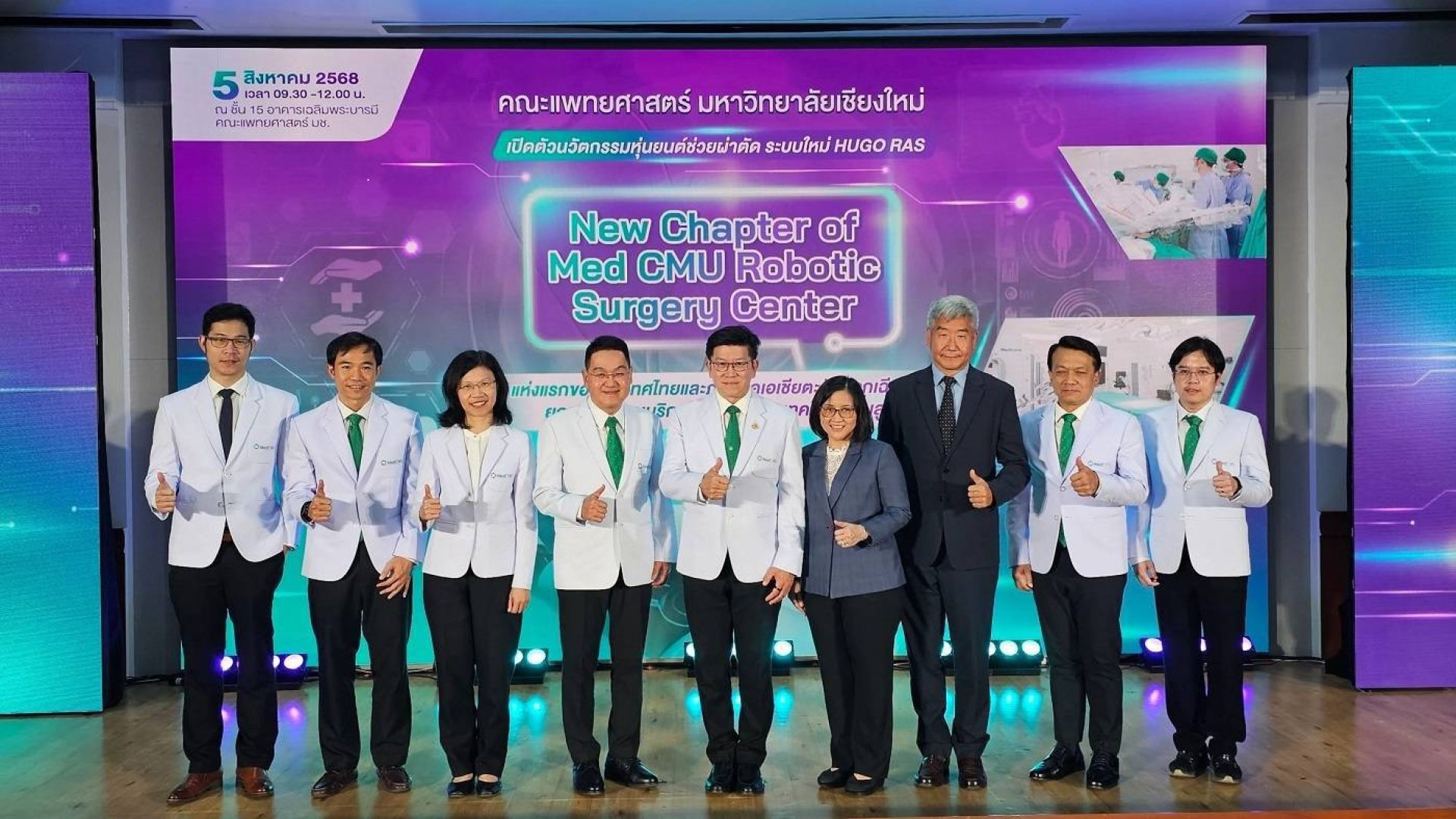
คณะแพทยศาสตร์ มช. เปิดตัว "นวัตกรรมหุ่นยนต์ช่วยผ่าตัด ระบบใหม่" (New Chapter of Med CMU Robotic Surgery Center) แห่งแรกของประเทศไทย และภูมิภาคเอเชียตะวันออกเฉียงใต้ ยกระดับระบบบริการสุขภาพด้วยเทคโนโลยีขั้นสูง การตอบสนองต่อความต้องการด้านสุขภาพของประชาชน ให้บริการทางการแพทย์อย่างมีประสิทธิภาพและหลากหลายทันสมัยอย่างสูงสุด
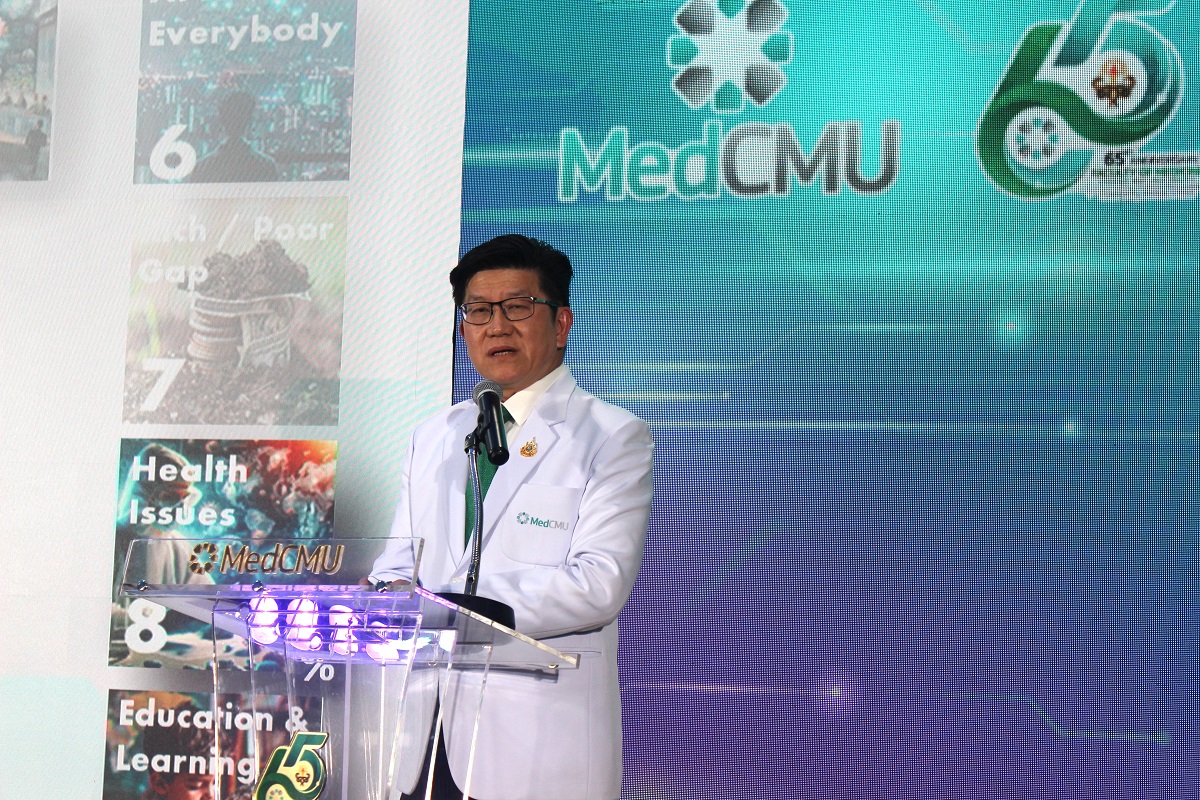
รศ.นพ.นเรนทร์ โชติรสนิรมิต คณบดีคณะแพทยศาสตร์ มช. เปิดเผยว่า คณะแพทยศาสตร์ มช. มุ่งมั่นพัฒนาระบบบริการสุขภาพตามแผนยุทธศาสตร์ของคณะแพทยศาสตร์ มช. ในปี 2568-2571 ที่จะต้องเป็นโรงเรียนแพทย์ในดวงใจ โดยยึดหลักนวัตกรรมและเน้นความยั่งยืนด้านสุขภาวะ โดยมีภารกิจในเรื่องของการขยายบริการและพัฒนาคุณภาพบริการทางการแพทย์เพื่อสร้างความเป็นเลิศในด้านบริการ สร้างความเชื่อมั่นต่อระบบบริการและเพิ่มพื้นที่บริการให้มากขึ้น เพื่อให้ประชาชนทุกกลุ่มสามารถเข้าถึงการรักษาอย่างมีประสิทธิภาพ และเกิดความเท่าเทียมในการเข้าถึงบริการทางการแพทย์และเป็นศูนย์กลางการแพทย์ในระดับนานาชาติ เป็นแบบอย่างของโรงเรียนแพทย์แห่งอนาคต และเป็นการยกระดับการบริการการรักษาผู้ป่วยด้วยเทคโนโลยีหุ่นยนต์ช่วยผ่าตัด โดยใช้เทคโนโลยีที่ทันสมัยที่สุดในปัจจุบันตามความตั้งใจ ที่เราจะพยายามนำเทคโนโลยีให้เข้าถึงเพื่อบริการทุกคน หรือความหมายคือ Technology for all ที่เชื่อมโยงองค์ความรู้การวิจัยและเทคโนโลยีเข้าด้วยกัน และเป็นการเปิดบทใหม่ของการรักษาในระบบสุขภาพของไทยด้วยหุ่นยนต์ผ่าตัดระบบใหม่ เป็นการพลิกโฉมการผ่าตัดยุคใหม่เป็นครั้งแรกในประเทศไทยและภูมิภาคเอเชียตะวันออกเฉียงใต้ ที่มีการใช้งานระบบหุ่นยนต์ช่วยผ่าตัดที่มีความแม่นยำสูง ยืดหยุ่น และเป็นมิตรกับทั้งศัลยแพทย์และผู้ป่วย โดยระบบนี้หุ่นยนต์ช่วยการผ่าตัดนี้ จะช่วยให้ศัลยแพทย์สามารถเข้าถึงการผ่าตัดที่ซับซ้อนในจุดที่เข้าถึงยากได้อย่างมีประสิทธิภาพ พร้อมลดภาวะแทรกซ้อน ฟื้นตัวเร็ว และลดความเจ็บปวดของผู้ป่วย
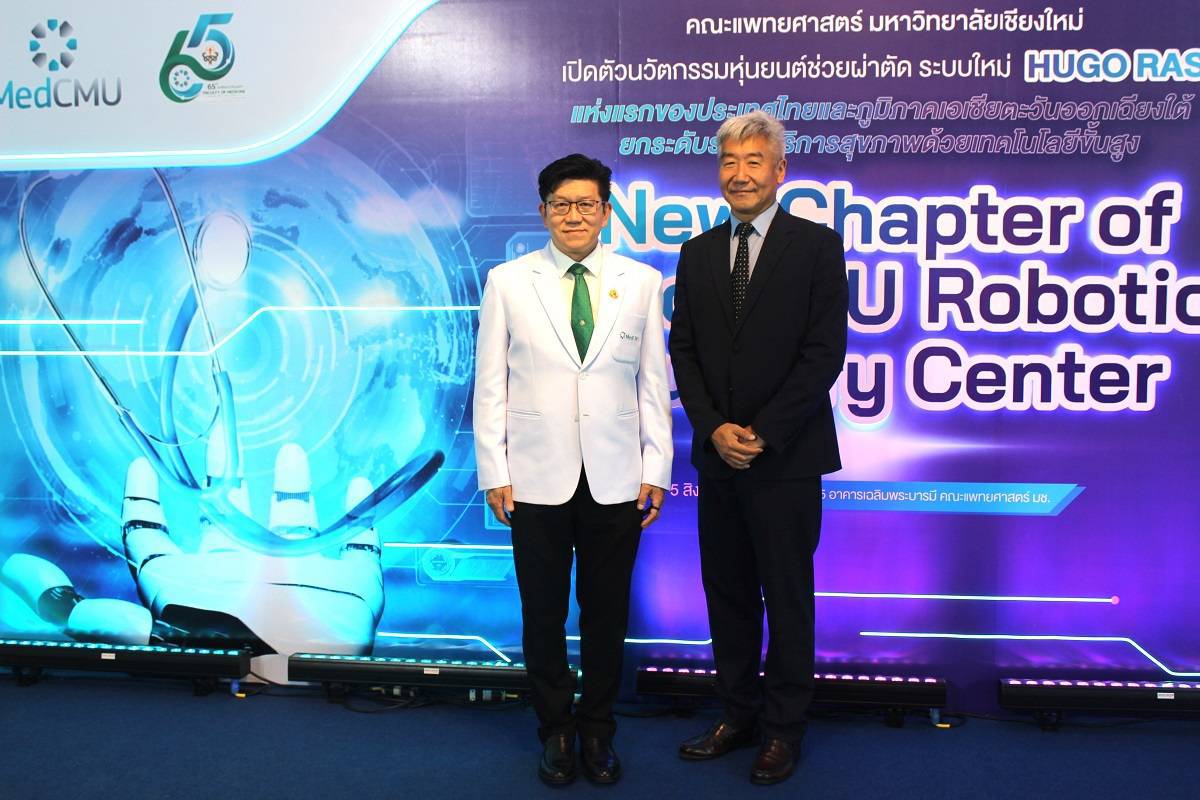

หุ่นยนต์ผ่าตัดระบบใหม่นี้ ได้รับการออกแบบให้เป็นแพลตฟอร์มแบบโมดูลาร์ที่สามารถทำหัตถการในหลายส่วนภายในร่างกาย ถูกออกแบบด้วยแนวคิด Modular Platform ที่ช่วยเพิ่มความคล่องตัวให้กับศัลยแพทย์ ด้วยแขนกลที่สามารถเลียนแบบการหมุนของข้อมือมนุษย์ แต่มีอิสระมากกว่า ทั้งยังมาพร้อมคอนโซลเปิดตามหลักสรีรศาสตร์ ทำให้ศัลยแพทย์สามารถควบคุมการผ่าตัดได้แม่นยำและสบายขึ้นแม้ต้องใช้เวลานาน นอกจากนี้ ยังส่งเสริมการเรียนรู้ร่วมกันผ่านจอแสดงผล 3 มิติแบบเรียลไทม์ ในขณะที่ศัลยแพทย์กำลังทำการผ่าตัดและผู้สังเกตการณ์สามารถดูภาพและสื่อสารร่วมกันได้ตลอดเวลา

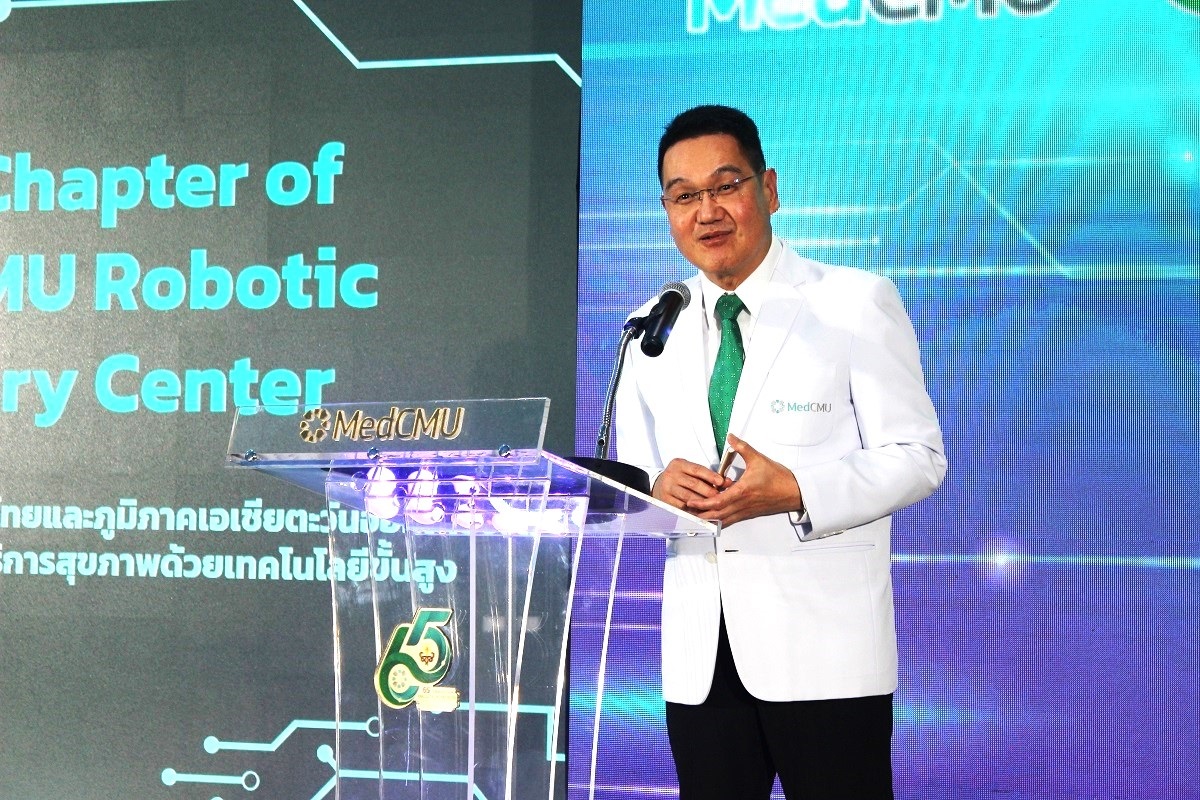
ด้าน ศ.(เชี่ยวชาญพิเศษ) นพ.บรรณกิจ โลจนาภิวัฒน์ ที่ปรึกษาผู้ทรงคุณวุฒิ คณะแพทยศาสตร์ มช. กล่าวเสริมว่าการใช้หุ่นยนต์ช่วยในการผ่าตัด มีประโยชน์หลายอย่างเพราะปลายแขนของหุ่นยนต์สามารถเคลื่อนไหวได้ดีกว่ามือของมนุษย์และการขยายภาพพร้อมระบบ 3 มิติที่มีความคมชัดสูง ช่วยให้ศัลยแพทย์สามารถมองเห็นอวัยวะ และโครงสร้างต่าง ๆได้อย่างชัดเจนมากขึ้นส่งผลให้การผ่าตัดมีประสิทธิภาพและความแม่นยำสูงขึ้น จึงสามารถลดภาวะแทรกซ้อนต่าง ๆ โดยเฉพาะลดการสูญเสียเลือดในขณะผ่าตัด และจากแผลผ่าตัดที่เล็กลง ทำให้อาการปวด ภายหลังการผ่าตัดน้อยกว่าการผ่าตัดด้วยวิธีเปิดแผลอย่างมีนัยสำคัญ และทำให้มีโอกาสติดเชื้อหลังการผ่าตัดลดลง ทำให้ผู้ป่วยกลับบ้านได้เร็วขึ้น และฟื้นตัวหลังการผ่าตัดได้รวดเร็วกว่า แพทย์ที่มีความชำนาญด้านการผ่าตัด และทีมผ่าตัดระบบหุ่นยนต์ช่วยผ่าตัดจึงจำเป็นต้องได้รับการฝึกอบรมอย่างดี เช่น การฝึกการใช้หุ่นยนต์ในสภาวะจำลอง (Simulation) การผ่าตัดภาคปฏิบัติในแบบจำลองสัตว์หรือห้องปฏิบัติการศพ (animal model, cadaveric lab) ก่อนการผ่าตัดในผู้ป่วยจริง โดยที่คณะแพทยศาสตร์ มช. มีแผนการผ่าตัดด้วยระบบหุ่นยนต์ช่วยผ่าตัดทุกแผนก เช่น ระบบทางเดินปัสสาวะ ระบบตับและตับอ่อน ระบบลำไส้ ระบบทางเดินอาหารส่วนบน ระบบนรีเวช และระบบช่องอก

สถิติการผ่าตัดด้วยหุ่นยนต์ช่วยผ่าตัดทั่วโลกมีอัตราเพิ่มขึ้นอย่างต่อเนื่องทุกปี ประเทศไทยก็มีแนวโน้มในทิศทางเดียวกัน โดยในปีที่ผ่านมามีจำนวนการผ่าตัดเพิ่มขึ้นจากปีก่อนหน้าร้อยละ 47 โรคที่มีการใช้หุ่นยนต์ช่วยผ่าตัดมากที่สุด ได้แก่ โรคในระบบทางเดินปัสสาวะ โดยเฉพาะโรคมะเร็งต่อมลูกหมาก นับตั้งแต่มีการติดตั้งระบบหุ่นยนต์ช่วยผ่าตัดแบบ Modulator และดำเนินการผ่าตัดรักษาผู้ป่วยรายแรกในเดือนมิถุนายนที่ผ่านมา ขณะนี้มีการผ่าตัดไปแล้วจำนวนทั้งสิ้น 16 ราย แบ่งเป็น มะเร็งต่อมลูกหมาก 11 ราย มะเร็งท่อไต 1 ราย และโรคในระบบตับอ่อน 4 ราย ผู้ป่วยทุกรายมีผลการรักษาที่ดี ไม่พบภาวะแทรกซ้อนจากการผ่าตัด และในระยะต่อไปจะมีการขยายการผ่าตัดด้วยหุ่นยนต์ไปยังโรคในระบบอื่น ๆ อย่างต่อเนื่อง
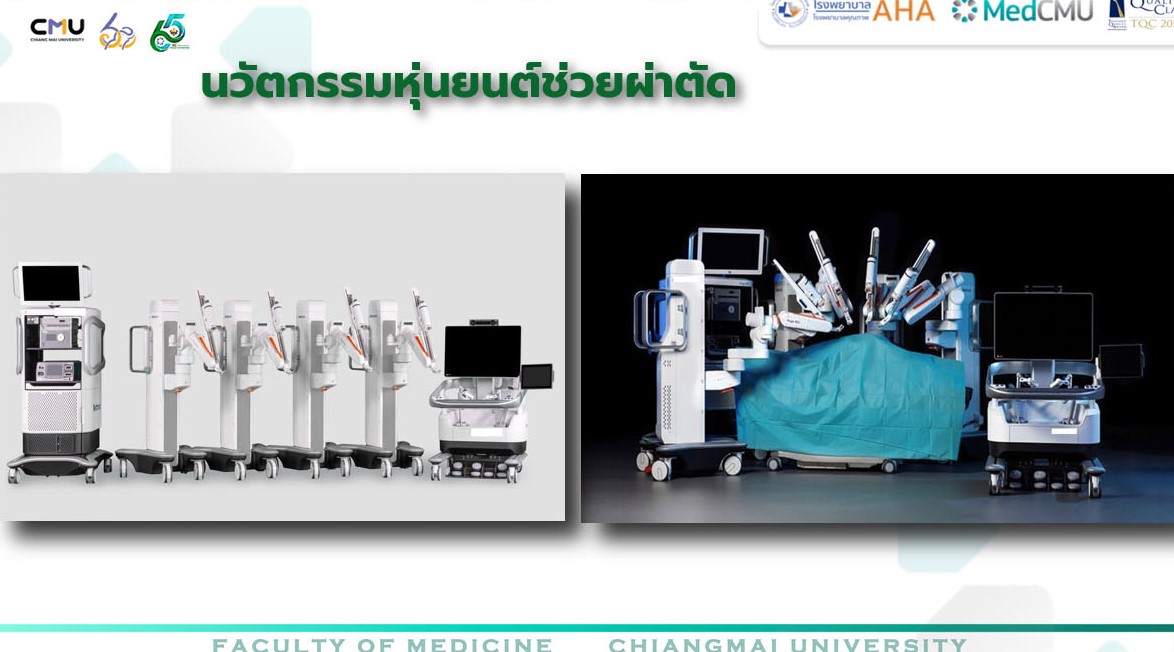
Faculty of Medicine, CMU, Launches Innovative Robotic Surgery System
New Chapter of Med CMU Robotic Surgery Center, the First in Thailand
and Southeast Asia, Elevating the Healthcare System with Advanced Technology
***
Chiang Mai The Faculty of Medicine, CMU, has launched the innovative robotic surgery system, New Chapter of Med CMU Robotic Surgery Center, the first in Thailand and Southeast Asia, elevating the healthcare system with advanced technology. This center addresses the public's health needs and provides the most efficient, diverse, and modern medical services.
Associate Professor Narain Chotirosniramit, M.D.Assoc., Dean of the Faculty of Medicine, CMU, revealed, "The Faculty of Medicine, CMU, is committed to developing the healthcare system in accordance with the Faculty of Medicine's strategic plan for 2025-2028, which aims to become a medical school of choice. This strategy emphasizes innovation and emphasizes sustainability in health care. Our mission is to expand and improve the quality of medical services to create service excellence, build confidence in the service system, and expand the service area, ensuring access to effective treatment for all groups of people." This will create equal access to medical services and serve as an international medical center, serving as a model for the medical school of the future. It will also elevate patient care services with robotic surgical technology, utilizing the most advanced technology available today. This commitment to making technology accessible to all, or "Technology for All," integrating research knowledge and technology, opens a new chapter in the Thai healthcare system with a new surgical robotic system. This revolutionary new surgical system is the first in Thailand and Southeast Asia to utilize a highly accurate, flexible, and friendly robotic surgical system that is both surgeon and patient-friendly. This system will enable surgeons to efficiently access complex surgical procedures in hard-to-reach areas, reducing complications, speeding recovery, and alleviating patient pain.
"This new surgical robotic system is designed as a modular platform capable of performing procedures on multiple parts of the body. It utilizes the Modular Platform concept, which enhances surgeon agility. Its robotic arm mimics the rotation of the human wrist, but with greater freedom. It also features an ergonomically designed open console, allowing surgeons to control surgical procedures more precisely and comfortably, even during long periods. Furthermore, it promotes collaborative learning through a real-time 3D display." While the surgeon is performing the surgery, observers can view and communicate with each other at any time.
Distinguished Professor Bannakij Lojanapiwat, M.D., a senior advisor at the Faculty of Medicine, CMU, added that robotic surgery offers numerous benefits. The robotic arm's movement is superior to that of a human hand, and its high-resolution 3D magnification and imaging system allows surgeons to see organs and structures more clearly, resulting in more efficient and accurate surgery. This reduces complications, particularly blood loss during surgery. Furthermore, the smaller incisions result in significantly less postoperative pain than open surgery, and the risk of postoperative infection is significantly reduced. This allows patients to return home faster and recover more quickly. Surgeons with expertise in robotic surgery and the robotic surgery team therefore require extensive training, including training in simulations and practical surgery in animal models or cadaveric labs, before performing surgery on real patients. The Faculty of Medicine, CMU, has a robotic surgery program for all departments, including the urinary system, hepatobiliary system, intestinal system, upper gastrointestinal system, gynecological system, and thoracic system.
Global robotic surgery statistics have been steadily increasing each year, with Thailand showing a similar trend. Last year, the number of surgeries increased by 47 percent compared to the previous year. The most commonly used conditions for robotic surgery are urinary tract diseases, particularly prostate cancer. Since the installation of the Modulator robotic surgery system and the first patient performed in June, a total of 16 surgeries have been performed: 11 for prostate cancer, one for renal tract cancer, and four for pancreatic cancer. All patients had good outcomes with no complications. Robotic surgery will continue to be offered to other diseases in the future.


